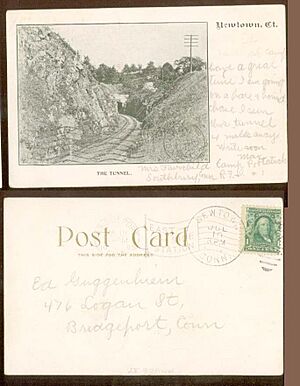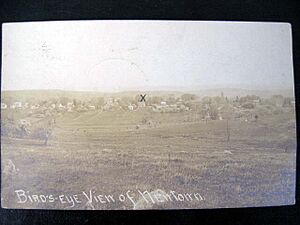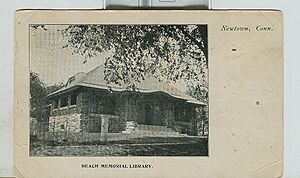History of Newtown, Connecticut facts for kids
The town of Newtown, Connecticut, has a rich history that dates back to the early 1700s. It started as a small settlement and grew over centuries, with many interesting changes along the way.
Contents
Early Days: The 1700s
| Newtown's Population Growth | |
| 1756 | 1,253 |
| 1774 | 2,229 |
| 1782 | 2,404 |
| 1790 | 2,764 |
| 1800 | 2,903 |
| 1810 | 2,834 |
| 1820 | 2,879 |
| 1830 | 3,096 |
| 1840 | 3,189 |
| 1850 | 3,338 |
| 1860 | 3,578 |
| 1870 | 3,681 |
| 1880 | 4,013 |
| 1890 | 3,539 |
| 1900 | 3,276 |
| 1910 | 3,012 |
| 1920 | 2,751 |
| 1930 | 2,635 |
| 1940 | 4,023 |
| 1950 | 7,448 |
| 1960 | 11,373 |
| 1970 | 16,942 |
| 1980 | 19,107 |
| 1990 | 20,779 |
| 2000 | 25,031 |
Newtown was first known as Quanneapague. Its land was bought from the Pohtatuck Indians in 1705. In 1708, 36 English settlers asked to start a town north of Stratford. These settlers became the first landowners, sharing the town's common land. Newtown officially became a town in 1711.
In 1709, the town's layout was planned. This plan included a wide main road, now called Main Street. It also had cross roads like West Street and Church Hill Road. In 1710, each of the 48 landowners received a 4-acre (about 1.6-hectare) plot for their homes. An extra plot was saved for the town's minister.
The first settlers were mostly farmers from nearby towns like Stratford and Milford. They were looking for more land to farm. Most families built their homes on the original plots near Main Street. Their houses were often built in styles like saltbox or Cape Cod cottage. They had barns, outbuildings, and small gardens.
Besides home plots, settlers also received land for farming and grazing. For example, each family got a 4-acre (about 1.6-hectare) meadow lot. They also received land for crop fields and a larger 20-acre (about 8-hectare) parcel elsewhere in town. Most of Newtown's land was divided up within 20 years.
Over time, some families moved away from the central village to be closer to their larger farms. One of the first new settlements was Sandy Hook. The Potatuck River at Sandy Hook was perfect for setting up sawmills and gristmills.
Other groups of settlers formed new areas, which later became school districts. By 1760, Newtown had seven school districts. By 1794, there were 20! These districts were removed in the 1920s, but their names are still used today to describe different neighborhoods. Some of these names include Dodgingtown, Hattertown, and Sandy Hook.
Newtown During the American Revolution
During the early American Revolutionary War, many people in Newtown supported the British. In 1781, French General Rochambeau and his soldiers camped in Newtown. They were on their way to the siege of Yorktown, which was the final battle of the Revolution.
The rooster weathervane on top of the Newtown Meeting House is a town symbol. People say that French soldiers used it for target practice during their stay!
Newtown in the 1800s
In the early 1800s, small factories started along Newtown's rivers. These factories used water power to run their machines. Hat making was an early industry, but bigger factories in nearby towns like Danbury later put them out of business.
Making buttons and combs was also popular. These items were made from animal horns, bones, and hooves, which were easy to find in a farming town. At one point, there were 14 button shops. However, after the American Civil War, plastic became popular, and the industry declined. One button shop, S. Curtis and Co., survived by changing to make cardboard boxes. Today, it is called Curtis Packaging, Inc.
The village of Hawleyville became an important railroad center for a short time. Around 1881, Newtown's population grew to over 4,000 people. However, it later dropped to a low of 2,635 in 1930 before growing again.
Other local industries included making furniture, tea bags, and fire hoses. People also farmed and mined for mica and feldspar.
The town's flag pole, which is still a well-known landmark, was first put up in 1876. The Newtown Bee, the local weekly newspaper, started in 1877. The Smith family has owned and run it since 1881.
Irish Immigrants Arrive
Newtown saw a big change when many Irish immigrants arrived in the 1800s. Many came as railroad workers and decided to stay and farm land that earlier farmers had left.
Most early Irish residents lived in the Sandy Hook and Walnut Tree Hill areas. They also settled on farms in the Botsford section of town. The arrival of the Irish changed the town's social, religious, and political life. For example, the Catholic church, St. Rose, saw a big increase in members. As more Irish moved in, the town's political majority changed from Republican to Democrat.
The number of Irish-American people in Newtown grew a lot. In 1850, they made up 5.6 percent of the population. By 1890, it was 41.8 percent, and by 1900, it was 44 percent. Many of these immigrants came from a small area in County Clare, Ireland.
Many Irish immigrants found jobs in local factories and button shops. The New York Belting and Packing rubber factory in town once employed 200 people, and 185 of them were Irish. Many Irish women worked as housekeepers, seamstresses, and lace makers.
There were some disagreements between the older residents and the new Irish immigrants. It wasn't until after World War II that the Irish were fully accepted in Newtown.
Newtown in the 1900s
Hawley School was built in the 1920s. Over the years, it has been a school for the whole town, a high school, and is now an elementary school. While it has had different uses, its main part has stayed much the same, though two additions have been built.
In the 1930s, several important buildings were constructed. The "Fairfield Hills" state mental hospital was built in the 1930s and closed in the 1990s.
Architect Philip Sutherland designed both the Edmond Town Hall and the Cyrenius H. Booth Library. Both were finished in the 1930s. The Edmond Town Hall has town offices, a movie theater, a gym, and rooms for events like weddings.
Newtown's Booth Memorial public library opened on December 17, 1932. It could hold 25,000 books. The library was a gift from Mary Elizabeth Hawley, named after her grandfather, a doctor in town. Her gift paid for the building and set up a fund so the town didn't have to pay for the library until the 1980s. The library was very modern for its time, with special floors and ceilings to keep it quiet. In 1998, an addition was built, doubling its size.
The famous game Scrabble was developed in Newtown! In 1948, a lawyer bought the rights to make the game. He changed the game's name from "Criss-Crosswords" to "Scrabble." He sold sets to stores like Macy's, which made the game very popular.
In 1961, Newtown changed its local government system. It now has a Board of Selectmen, with a First Selectman as the town's main leader. There is also a Legislative Council and a Board of Finance.
Newtown in the 2000s
The town bought the Fairfield Hills mental hospital property. As of 2007, they were still deciding how to use the land.





